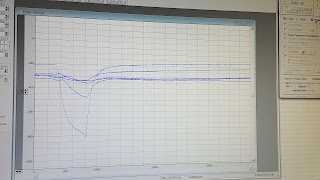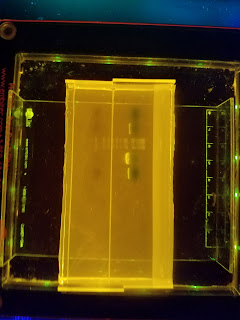Week 2
Hey, everyone! I'm back with another weekly summary of my activities at BNI.
The materials for my project finally arrived this week! We started preparing them while working on the zinc-activated ion channel project that I was working on last week.
On Monday, I continued collecting data from the oocytes using the voltage clamp and the same chemicals. Although we were getting consistent responses from some of the eggs, they were definitely less robust, and most of the eggs did not produce any response at all. This was most probably because the eggs had weakened over the weekend, as they had been originally injected with the ion channel DNA one whole week ago.
The materials for my project finally arrived this week! We started preparing them while working on the zinc-activated ion channel project that I was working on last week.
On Monday, I continued collecting data from the oocytes using the voltage clamp and the same chemicals. Although we were getting consistent responses from some of the eggs, they were definitely less robust, and most of the eggs did not produce any response at all. This was most probably because the eggs had weakened over the weekend, as they had been originally injected with the ion channel DNA one whole week ago.
What the reading from the voltage clamp looks like on the computer. The troughs indicate activation of the zinc-activated ion channels due to various concentrations of the surrounding solution.
On Tuesday, we attended a luncheon/presentation at Barrow about the production and usage of research-grade cigarettes, which are often used to study the effects of nicotine on human subjects. After returning to the lab, I injected some more eggs with the ion channel DNA and disposed of the deteriorating ones.
Late in the afternoon, the first set of plasmids (circular DNA fragments) required for my project arrived via FedEx, so my mentor quickly showed me how to culture the bacteria (i.e. make them take up the DNA and clone it through their natural reproduction).
On Wednesday, we picked up the culture after it had been stirred overnight, placed them in the fridge, and returned to the zinc-activated ion channel experiment. Unfortunately, the recently injected eggs did not exhibit much of a response either, possibly because they were still from the same batch we had initially obtained over a week ago.
That afternoon, Dr. Chang went over the process of isolating and extracting the replicated DNA from the bacterial culture so that we could do it the next day.
The final shipment of DNA arrived Thursday morning, so we picked it up and similarly cultured some E. coli with it. (They're currently sitting in a large shaker, which constantly swirls the liquid to encourage growth.)
Finally, we performed the extraction procedure, which involves lysing (perforating) the bacterial cell walls to allow the DNA to spill out, then adding various chemicals and centrifuging the mixture several times to filter and purify the DNA. We'll do the same thing with the rest of the DNA next week, as this week my mentor is out of town.
Thanks for tuning in!
Late in the afternoon, the first set of plasmids (circular DNA fragments) required for my project arrived via FedEx, so my mentor quickly showed me how to culture the bacteria (i.e. make them take up the DNA and clone it through their natural reproduction).
On Wednesday, we picked up the culture after it had been stirred overnight, placed them in the fridge, and returned to the zinc-activated ion channel experiment. Unfortunately, the recently injected eggs did not exhibit much of a response either, possibly because they were still from the same batch we had initially obtained over a week ago.
That afternoon, Dr. Chang went over the process of isolating and extracting the replicated DNA from the bacterial culture so that we could do it the next day.
The final shipment of DNA arrived Thursday morning, so we picked it up and similarly cultured some E. coli with it. (They're currently sitting in a large shaker, which constantly swirls the liquid to encourage growth.)
Finally, we performed the extraction procedure, which involves lysing (perforating) the bacterial cell walls to allow the DNA to spill out, then adding various chemicals and centrifuging the mixture several times to filter and purify the DNA. We'll do the same thing with the rest of the DNA next week, as this week my mentor is out of town.
Thanks for tuning in!



Comments
Post a Comment